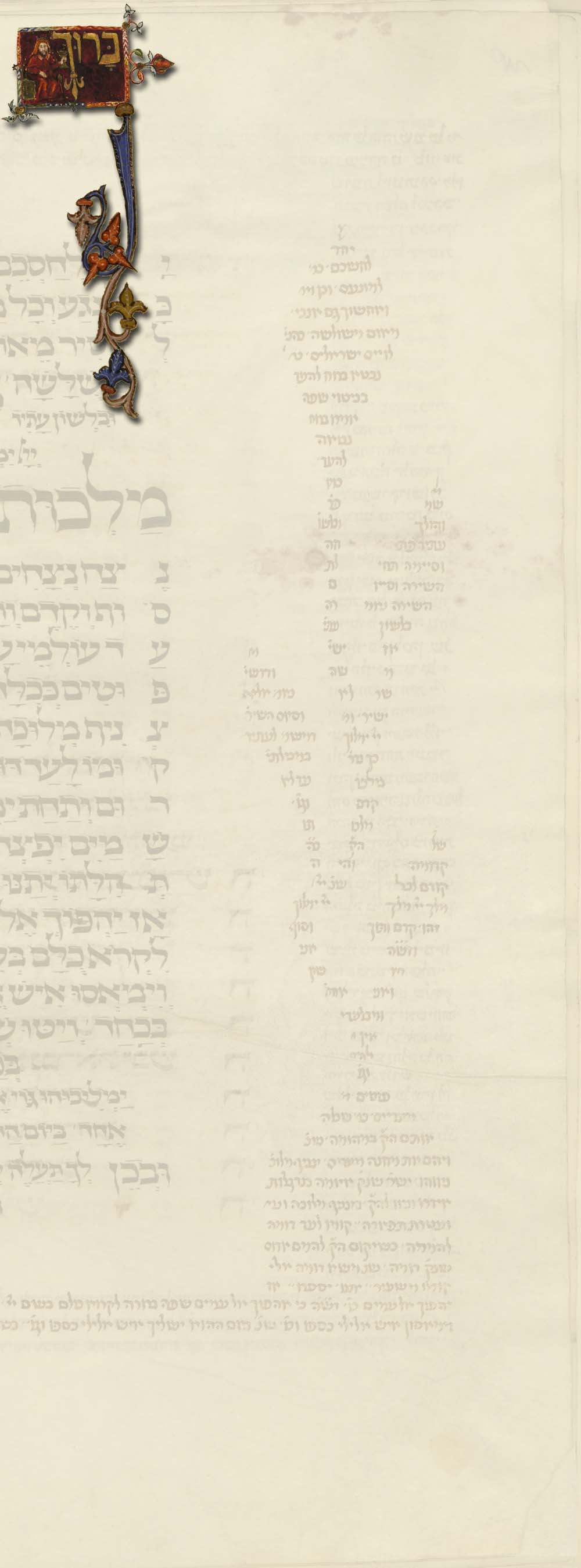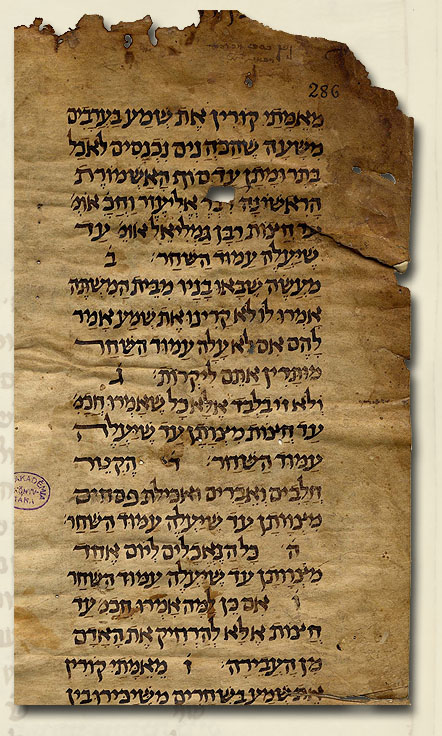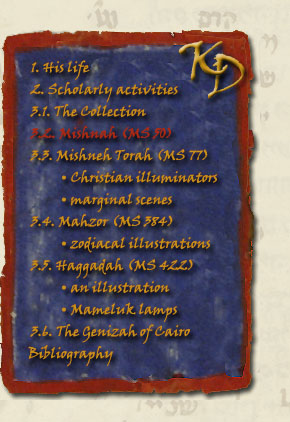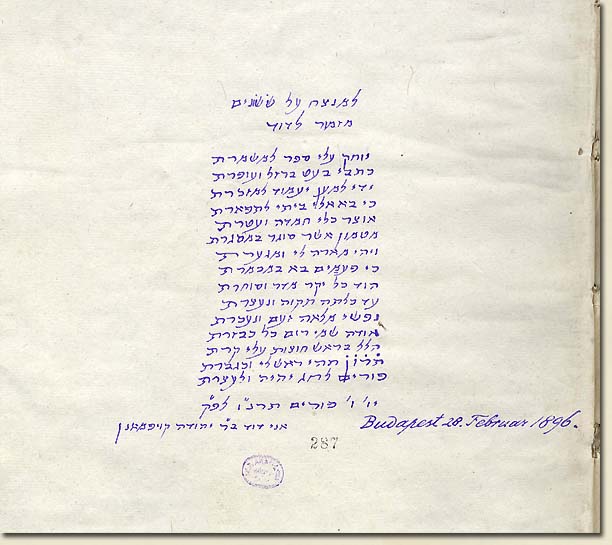


 3.2.
Mishnah (MS A 50)
3.2.
Mishnah (MS A 50)

The most important manuscript in the collection is no doubt the Mishna manuscript, shelf-mark MS Kaufmann A 50, which is sometimes referred to as the Codex Kaufmann (fig. 1). There are three complete manuscripts extant of the Mishna and ours is regarded as the oldest and best of them. 71 It does not have a colophon, so views differ as to its age and origin. Ignaz Goldziher considered it to be of South Arabian origin while Samuel Krauss and recently Malachi BEIT-ARIÉ thought it had been written in Italy. Goldziher does not mention on what basis he made this statement.
As for
Krauss, he was just in the process
of making a thorough investigation of the manuscript when the collection was
presented to the Academy and the new owners asked him to return it without
delay. Thus he was not able to carry out his plan having been compelled to
confine himself to the orders Nashim and Neziqin only. His
assumption, which he seems to have based on an orthographic peculiarity
occurring only in a few places, the use of an alef prostheticum before
the sound/letter <s>, a habit mostly characteristic of Italians, is now shared
by the majority of scholars, although
 on the basis of additional considerations,
while the view has also been advanced that the manuscript probably comes from
Palestine. 72
It was written in the tenth or eleventh century. For more details we turn now to
one of our visitors:
on the basis of additional considerations,
while the view has also been advanced that the manuscript probably comes from
Palestine. 72
It was written in the tenth or eleventh century. For more details we turn now to
one of our visitors:
Script and form of letters closely resemble certain MSS. of the Bible of eastern origin, written in the tenth or eleventh century. The MS. contains comments, mostly emendations of the text, contributed by several hands. The emendations of one particular hand are constant and form the majority. The same hand also vocalized the codex. This vocalization was not inserted by the original scribe but was done probably some centuries later, when it was transferred from a vocalized copy which offered a text differing much from the Kaufmann codex. The punctator inserted these variations into the Kaufmann codex. The pointing and the emendations from the punctator display a second MS. belonging to another recension. The peculiarities of the Kaufmann MS. are more numerous than in any other, including most of the Geniza fragments. It has kept older forms of the Palestinian type of text and it often reflects the spoken language of second century Palestine. The Kaufmann codex is undoubtedly the oldest complete Mishna text and contains the best readings, even though it does not seem as faithful as the Cambridge codex in preserving the Palestinian recension. Hence the Kaufmann codex must now be regarded as the basic text of all scientific editions. 73
Kaufmann acquired the manuscript in 1896 after all sorts of difficulties, and he gave expression to his great joy in his own “Psalm of David” which he wrote in his well-known violet ink on the flyleaf in the front part of the manuscript. (David is of course an allusion to himself here.) 74

71 The other two are MS Parma, De
Rossi 138 (Parma, Bibliotheca Palatina no. 3173) and the MS Cambridge,
Add. 470 (II) (Cambridge, University Library). The MS Parma was written
around 1073 while the MS Cambridge comes from the 14th or 15th century.
Michael Krupp:
Manuscripts of the Mishna. The three complete Mishna manuscripts.
In: The literature of the Sages I. Editor: Shmuel Safrai.
Assen/Maastricht – Philadelphia 1987. 253-254. See also Benjamin
Richler’s contribution to
the present volume.
72
Goldziher Ignác:
Kaufmann Dávid könyvtára. [= The Library of David
Kaufmann]. (Olvasta Goldziher
Ignácz r. t. az április 23-iki ülésen. [=Read by ordinary member Ignácz
Goldziher in the session of 23 April.]) In: Akadémiai Értesítő [Bulletin
of the Academy] 18 (1906) 309. = Microcard catalogue of the
rare hebrew codices, manuscripts and ancient prints in the Kaufmann
Collection reproduced on microcards. Introduced by a lecture of the
late Prof. Ignácz Goldziher. (Publications of the Oriental Library of
the Hungarian Academy of Sciences, IV.) Microcard catalogue of the
Kaufmann Collection. Editor R. Gergely. Budapest 1959. 15.
Malachi BEIT-ARIÉ 2003.
54-55. Samuel
Krauss: Die
Kaufmann'sche Mischna-Handschrift. In: Monatsschrift für Geschichte
und Wissenschaft des Judentums 51 (1907) 460.
Krauss 1907. 65.
Krupp 1987. 253-254.
73
Krupp 1987. 253. Cf. also
Krauss 1907. 54-66,
142-163, 323-333, 445-461.
74 It is quoted in
Weisz 1906. 14. – It may be
noted that while Kaufmann's
handwriting in Latin script cannot be regarded as aesthetic in any way
and creates the impression of an unbalanced mind, his handwriting
becomes simply beautiful and a reflection of harmony itself when he is
using square Hebrew script. There is a striking contrast between the
two, which would surely make a most interesting subject for study by a
graphologist.
